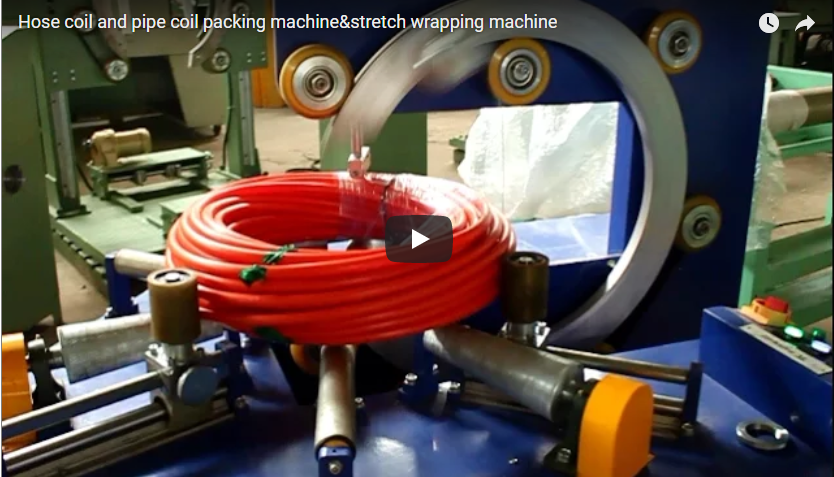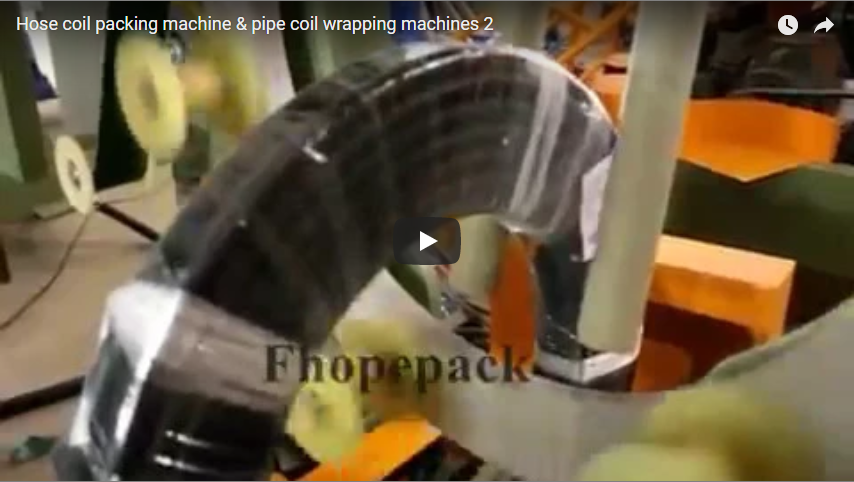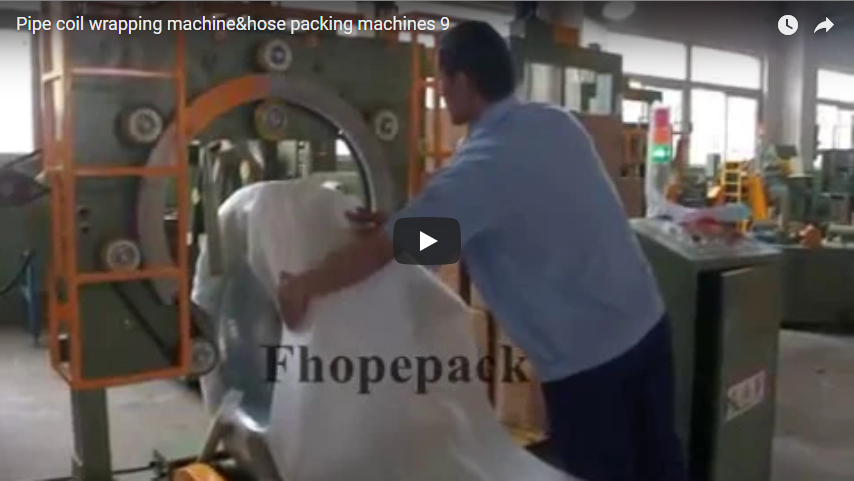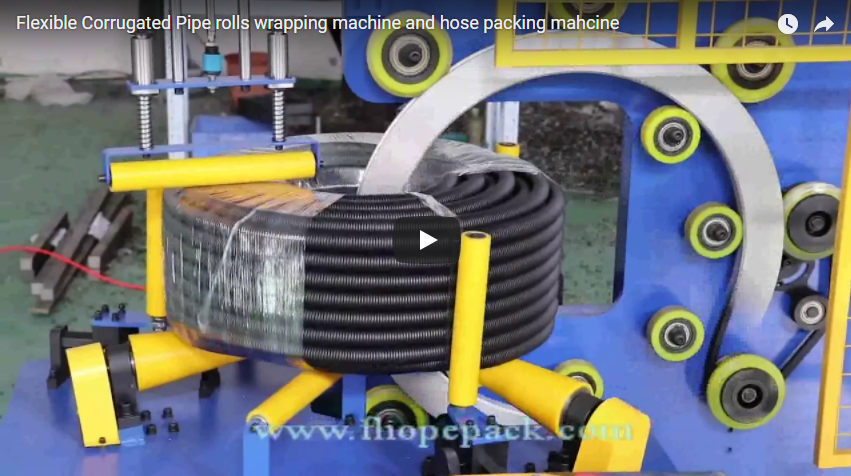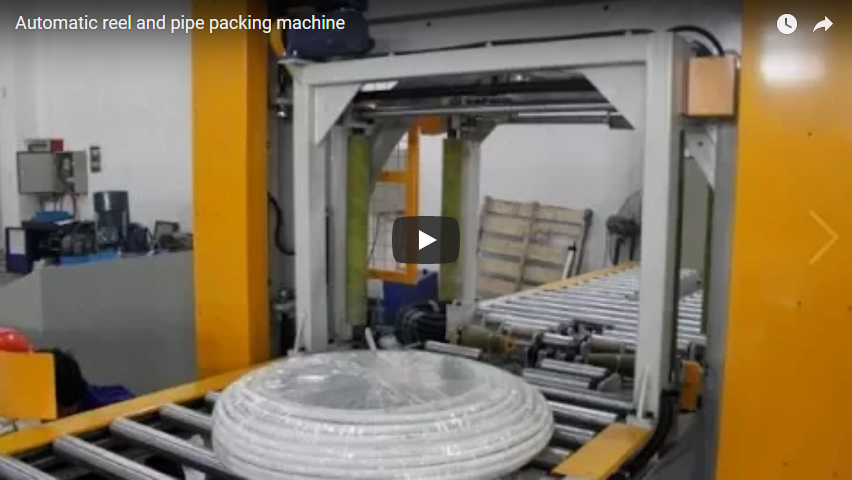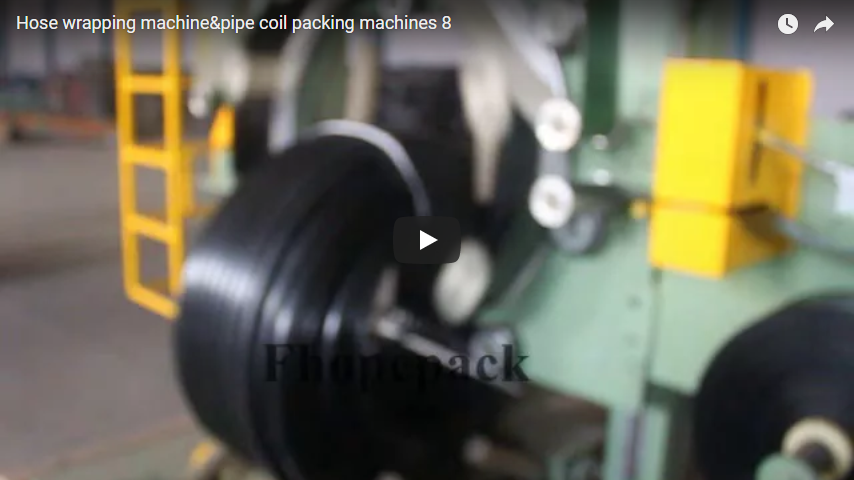Optimizing Pipe and Hose Coil Packaging with Orbital Stretch Wrapping Machines
Efficiently packaging coiled products like pipes, hoses, and cables is essential for protection during transit and storage, as well as for professional presentation. Manual wrapping is often slow, inconsistent, and labor-intensive. Automated orbital stretch wrapping machines offer a streamlined solution, particularly for delicate or lightweight coils.
(Original video embed retained and updated)
1. Understanding Orbital Stretch Wrapping for Coils
An orbital stretch wrapper, often called a horizontal stretch wrapper or coil wrapper, is specifically designed to apply stretch film around the circumference of a coiled product through its center eye. This creates a tight, secure, and protective layer that conforms to the product's shape. Unlike turntable wrappers used for pallets, the film roll orbits around the stationary or indexed coil.
This machine type is particularly adept at handling products like:
- Corrugated hoses
- Hydraulic hoses
- PEX pipes
- Wires and cables
- Smaller diameter HDPE pipes
- Other flexible coiled materials
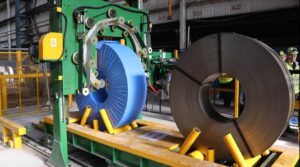
coil wrapping machine fhope 2. Key Technical Specifications and Features
When evaluating or understanding these machines, consider the following typical parameters (note: specific values vary significantly by model and manufacturer):
- Coil Dimensions Handling:
- Outer Diameter (OD): e.g., 300mm - 1500mm
- Inner Diameter (ID): e.g., 150mm - 800mm
- Coil Width/Height: e.g., 50mm - 500mm
- Maximum Coil Weight: e.g., 50kg - 500kg (can be much higher for heavy-duty models)
- Wrapping Performance:
- Ring Speed (Orbital Speed): e.g., 60 - 120 RPM (Revolutions Per Minute)
- Typical Wrapping Cycle Time: 15 - 40 seconds per coil (depending on size and wraps required)
- Stretch Film Specifications:
- Film Roll Width: e.g., 100mm - 250mm
- Film Roll Outer Diameter: e.g., 150mm - 250mm
- Film Core Inner Diameter: Typically 76mm (3 inches)
- Film Type: LLDPE (Linear Low-Density Polyethylene) stretch film
- Film Thickness: e.g., 17 - 35 microns
- Machine Systems:
- Control System: PLC (Programmable Logic Controller) with HMI (Human Machine Interface) touchscreen
- Film Delivery System: Often features pre-stretch capabilities (e.g., up to 250%) to maximize film yield and load containment.
- Film Cut & Clamp: Automated systems for starting and ending the wrap cycle cleanly.
- Conveying System: Can include powered or non-powered infeed/outfeed conveyors for integration into production lines.
- Safety Features: Guarding, emergency stops, safety interlocks.
3. The Automated Wrapping Process Explained
The typical operation sequence for an automated orbital coil wrapper involves these steps:
- Loading: The pipe or hose coil is placed onto the machine's loading area, often support rollers or an infeed conveyor. The coil is positioned so the wrapping ring can pass through its center.
- Initiation: The operator starts the cycle via the control panel or a footswitch.
- Film Application: The wrapping ring, carrying the stretch film roll, begins to orbit around the coil while simultaneously rotating through the coil's eye.
- Coil Rotation (Optional/Indexing): Depending on the machine design and desired wrap pattern, the coil itself may be slowly rotated or indexed by powered support rollers during the wrapping cycle to ensure even film coverage across the coil's width.
- Wrapping Cycle: The film is dispensed and stretched (if using a pre-stretch system) as the ring orbits. The number of wraps and overlap percentage are typically programmable via the HMI.
- Film Cut and Secure: Once the programmed wraps are complete, an automated mechanism clamps the film, cuts it cleanly, and often uses a brush or heat sealer to secure the film tail to the coil.
- Unloading: The securely wrapped coil is removed from the machine, either manually or via an outfeed conveyor system.
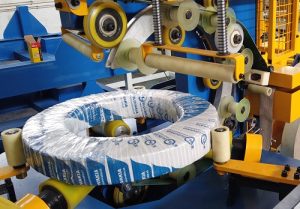
coil packing 4. Benefits of Automated Coil Wrapping
Transitioning from manual wrapping to an automated orbital system provides several advantages:
- Increased Throughput: Dramatically reduces wrapping time per coil (e.g., 15-30 seconds vs. several minutes manually), boosting overall packaging line efficiency.
- Consistent Wrap Quality: Ensures every coil is wrapped uniformly with the correct tension and film overlap, leading to stable and professional-looking packages.
- Enhanced Product Protection: Provides superior protection against dust, moisture, dirt, and minor impacts during handling, storage, and shipping. The tight wrap helps maintain coil integrity.
- Improved Load Security: Prevents coils from unwinding or becoming loose.
- Reduced Labor Costs: Frees up personnel previously dedicated to manual wrapping for other value-added tasks.
- Material Savings: Powered pre-stretch systems can significantly reduce film consumption compared to manual wrapping or machines without pre-stretch.
- Operator Safety: Reduces risks associated with repetitive motions and manual handling of heavy or awkward coils during the wrapping process.
5. Practical Considerations and Experience Sharing
- Matching Machine to Product: Carefully match the machine's specifications (coil size range, weight capacity) to your specific product range. Consider future needs as well.
- Film Selection: The right type, thickness (micron), and pre-stretch capability of the film are crucial for optimal performance and load containment without damaging delicate products. Test different films if necessary.
- Maintenance: Regular maintenance, including cleaning sensors, checking roller condition, and inspecting the film cutting mechanism, is vital for reliable operation. Follow the manufacturer’s recommended schedule.
- Integration: Consider how the machine fits into your overall workflow. Will it be a standalone station, or does it need integration with existing conveyor systems?
- Operator Training: Ensure operators are properly trained on safe operation, setting wrap parameters, film loading, and basic troubleshooting.
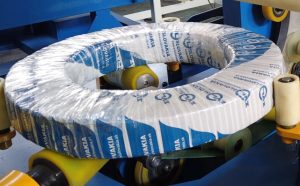
small coil wrapping 2 4 6. Conclusion
Automated orbital stretch wrapping machines represent a significant upgrade for packaging pipe, hose, and other coiled products. By offering high speed, consistency, enhanced protection, and operational efficiencies, these machines address the challenges of manual wrapping. While the initial investment requires careful consideration of technical specifications and application needs, the long-term benefits in terms of productivity, product integrity, and cost savings are substantial for manufacturers and distributors handling coiled goods.
(Original internal link retained)
https://www.fhopepack.com/Hose-packaging-machine/
(Contact email retained as requested, though typically better on a dedicated contact page)
info@fhopepack.com

